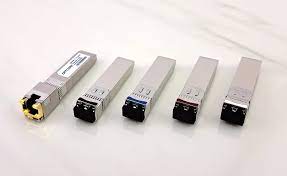Transceivers and Network Switches: A Guide to SFP, SFP+, and QSFP28 Modules

In today’s fast-paced and interconnected world, the need for high-speed data transfer has never been greater. To meet this demand, network switches and other networking equipment rely on transceivers to convert electrical signals to optical signals and vice versa. Among the most popular transceiver modules are the SFP, SFP+, and QSFP28. In this article, we will explore the features and advantages of each module and how they can be used to build high-performance networks.
SFP Module
SFP (Small Form-factor Pluggable) modules are a type of hot-swappable transceiver that supports data rates of up to 10Gbps. They are commonly used in switches, routers, and other networking equipment. SFP modules use LC (Lucent Connector) or SC (Subscriber Connector) connectors to attach to the fiber optic cables. SFP modules are also available in copper, allowing them to connect to twisted-pair copper cables. They are typically used in low to medium-range applications and have a maximum range of around 40km.
SFP+ Module
SFP+ (Small Form-factor Pluggable Plus) modules are an upgraded version of the SFP module that can support data rates of up to 16Gbps. SFP+ modules use the same form factor as SFP modules, making them backward compatible. They can also use the same LC or SC connectors as SFP modules and are available in copper or fiber optic variants. SFP+ modules are commonly used in high-performance computing and data center applications and can have a range of up to 80km.
QSFP28 Module
QSFP28 (Quad Small Form-factor Pluggable 28) modules are the newest and most advanced transceiver modules available. They are capable of supporting data rates of up to 100Gbps and can transmit over long distances, up to 100km. QSFP28 modules are available in both single-mode and multi-mode variants and use an MPO (Multi-Fiber Push-On) connector to connect to the fiber optic cables. QSFP28 modules are commonly used in data center interconnects, cloud computing, and other high-performance applications.
Network Switch
Network switches are devices that connect multiple devices on a computer network, allowing them to communicate with each other. Switches use a combination of hardware and software to route data packets to their destination. They typically have multiple ports, each of which can connect to a different device. Switches can be used to build networks of various sizes, ranging from small home networks to large enterprise networks. They can also be used to segment a network into smaller subnets, improving performance and security.
Conclusion
Transceiver modules are an essential component of modern computer networks. They allow for high-speed data transfer over long distances, making it possible for devices to communicate with each other across the globe. The SFP, SFP+, and QSFP28 modules are popular choices for network switches and other networking equipment. Each module has its unique features and advantages, and the choice of which module to use depends on the specific requirements of the network. When combined with a reliable network switch, these modules can help build a high-performance network that can meet the demands of today’s fast-paced and interconnected world.
Apart from this, if you are interested to know more about Choosing Between OEM then visit our Al Tech category




